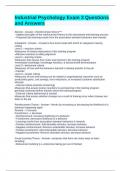Exam (elaborations)
Industrial Psychology Exam 3 Questions and Answers
- Course
- Institution
Skinner - Answer---Reinforcement theory*** --Applied principles of the reinforcement theory to the educational and learning process --Proposed that learning results from the association between behaviors and rewards Kirkpatrick - Answer---Created a four level model with which to categorize tra...
[Show more]



